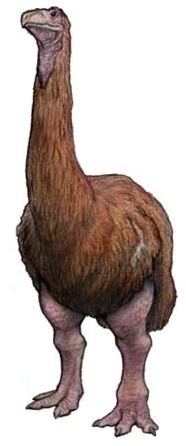
The Elephant bird, Aepyornis (1851)
Phylum : Chordata
Class : Aves
Superorder : Paleognathae
Order : Aepyornithiformes
Family : Aepyornithidae
Genus : Aepyornis
Species : A. maximus, A. gracilis, A. medius, A. hildebrandti
- Extinct in XVII century
- 3 m high and 400 kg
- Madagascar
Aepyornis maximus is commonly known as the ‘elephant bird’, a term that apparently originated from Marco Polo’s account of the rukh in 1298, although he was apparently referring to an eagle-like bird strong enough to “seize an elephant with its talons”. Sightings of eggs of elephant birds by early sailors could also have been erroneously attributed to a giant raptor from Madagascar. The legend of the roc could also have originated from sightings of such a giant subfossil eagle related to the African Crowned Eagle, which has been described in the genus Stephanoaetus from Madagascar, being large enough to carry off large primates; today, lemurs still retain a fear of aerial predators such as these. Another might be the perception of ratites retaining neotenic features and thus being mistaken for enormous chicks of a presumably more massive bird.
It is widely believed that the extinction of Aepyornis was an effect of human activity. The birds were initially widespread, occurring from the northern to the southern tip of Madagascar. One theory states that humans hunted the elephant birds to extinction in a very short time for such a large landmass (the blitzkrieg hypothesis). There is indeed evidence that they were killed. However, their eggs may have been the most vulnerable point in their life cycle. A recent archaeological study found fragments of eggshells among the remains of human fires, suggesting that the eggs regularly provided meals for entire families.
The exact time period when they died out is also not certain; tales of these giant birds may have persisted for centuries in folk memory. There is archaeological evidence of Aepyornis from a radiocarbon-dated bone at 1880 +/- 70 BP (c. 120 AD) with signs of butchering, and on the basis of radiocarbon dating of shells, about 1000 BP (= c. 1000 AD). It is thought that Aepyornis is the Malagasy legendary extinct animal called the vorompatra, Malagasy for “marsh bird” (vorom translates to “bird”). After many years of failed attempts, DNA molecules of Aepyornis eggs were successfully extracted by a group of international researchers and results were published in the Proceedings of the Royal Society B.
It has also been suggested that the extinction was a secondary effect of human impact due to transfer of hyperdiseases from human commensals such as chickens and guineafowl. The bones of these domesticated fowl have been found in subfossil sites in the island, such as Ambolisatra (Madagascar), where Mullerornis sp. and Aepyornis maximus have been reported.
David Attenborough in a BBC Television program transmitted in early 2011 said that “very few Aepyornis bones show signs of butchery, so likely there was a Malagasy native taboo against killing Aepyornis, and that is likely why Aepyornis survived so long after Man arrived there.”. But that does not say anything about whether the natives took so many Aepyornis eggs that the species died out.
I did my undergraduate thesis on these and the other large flightless birds in the Ratite group. They have a very interesting and complicated evolutionary history.
As for the sightings of Marco Polo, interesting evidence has come to light about the rukh/roc/giant eagle. In a conversation with the Steve Goodman at the Field Museum of Natural History, he mentioned that he and his colleagues have found evidence of a giant eagle (subfossil bones), possibly the largest ever, alongside subfossil lemur remains and such from <4000 years BP. I think it likely that it was this bird to which Marco Polo was referring.
mattdvm liked this
 admantus reblogged this from palaeopedia
admantus reblogged this from palaeopedia disgustedorito liked this
 sixth-extinction reblogged this from palaeopedia
sixth-extinction reblogged this from palaeopedia miroweart reblogged this from shrikestrike
kruziikqeth reblogged this from palaeopedia
gommetrik reblogged this from palaeopedia
paperyplastic liked this
corvusantipodum reblogged this from palaeopedia
corvusantipodum liked this
thescientificgap-blog liked this
magusmagusmagus liked this
alliieennss liked this
 homonymph reblogged this from theartfulblogger
homonymph reblogged this from theartfulblogger somanyshowssolittletime liked this
mondaymorgue liked this
mrevans123 liked this
goatpopburgerpunk-blog liked this
paparocadoc liked this
 badatparties-blog liked this
badatparties-blog liked this wendyowendyodogdogwendyo-blog reblogged this from somuchscience
wendyowendyodogdogwendyo-blog liked this
sarw4n liked this
ultimatemomfan reblogged this from sheepheadfred
rugelach-blog reblogged this from somuchscience
comix liked this
palaeopedia posted this
- Show more notes
